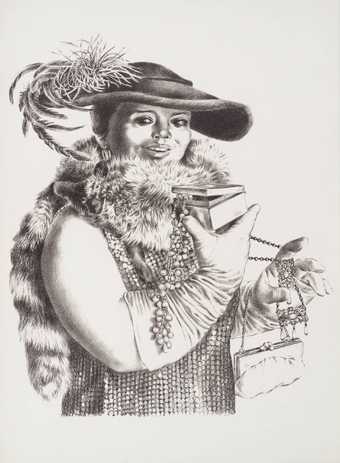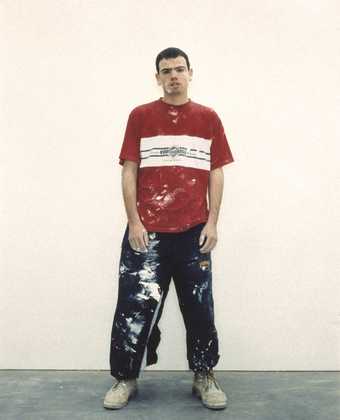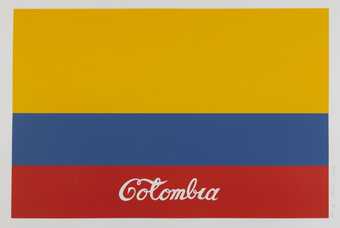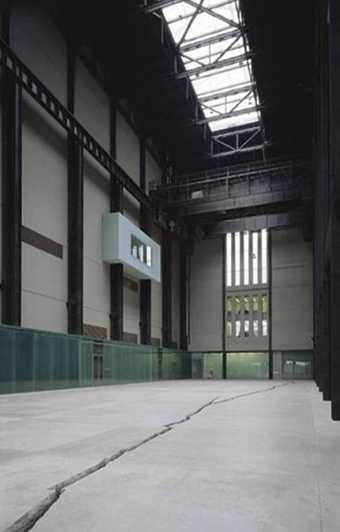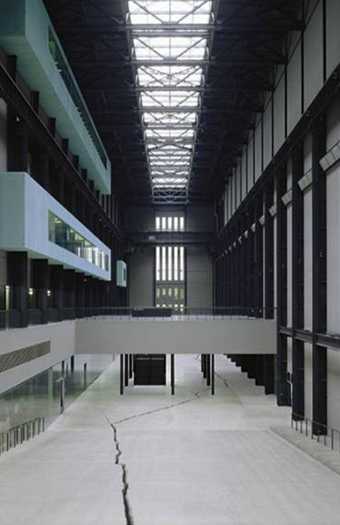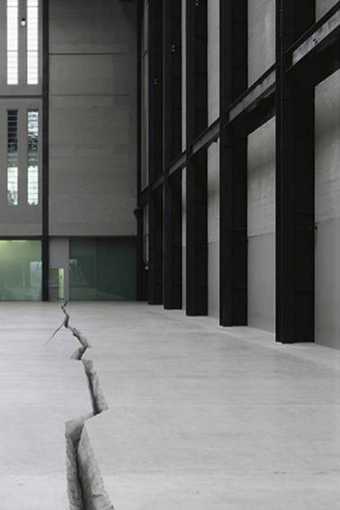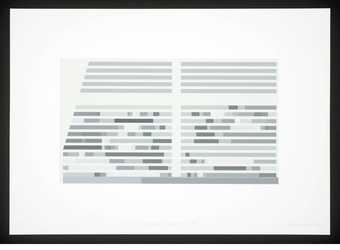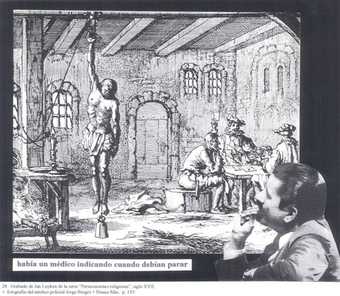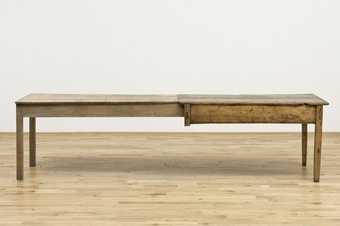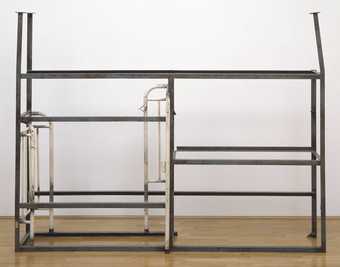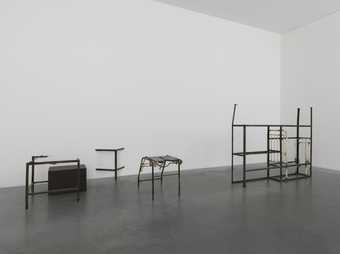
In Tate Modern
- Artist
- Doris Salcedo born 1958
- Part of
- Shibboleth
- Medium
- Digital print on paper
- Dimensions
- Image: 640 × 490 mm
Paper Support: 754 × 591 mm - Collection
- Tate
- Acquisition
- Presented by the artist, White Cube, London and Alexander and Bonin, New York 2008
- Reference
- P20335
Summary
Shibboleth II is a medium-size digital photograph by the Colombian artist Doris Salcedo that depicts the Turbine Hall of Tate Modern, London, with a long narrow crack running along its floor. The print is part of a portfolio of four photographs each showing different views of the same scene, including Shibboleth I (Tate P20334), Shibboleth III (Tate P20336) and Shibboleth IV (Tate P20337), and the portfolio as a whole is number one in an edition of forty-five plus ten artist’s proofs. The photographs were made as part of Salcedo’s 2007 installation project for the Unilever Series at Tate Modern, also titled Shibboleth, which involved the artist creating a deep fissure in the floor of the Turbine Hall that stretched from one end of the gallery to the other, into which she placed a concrete cast of a Colombian rock face with a wire chain-link fence set into it. These photographs are digital composites made up of images of the Turbine Hall seen from four different angles and photographs that Salcedo took of a small-scale model of the cracked floor that she made in her studio in Bogotá, Colombia.
Salcedo began making these photographs in April 2007 and finished them in October of that year, the same month that the Shibboleth installation opened in the Turbine Hall. To produce these works, Salcedo asked Tate to provide colour transparencies of four specific views of the Turbine Hall. These were scanned at Laumont, a printing studio in New York, and the scans sent to Salcedo in Bogotá, who digitally added the images of the crack into the scenes. These digital renderings were then sent back to Laumont, who printed the portfolios on Hahnemühle Photo Rag, a medium-heavy weight white wove paper, using the archival pigment inkjet printing process. All four images in the portfolio are the same height and approximately the same width and each is titled, editioned, signed and dated in graphite at the bottom right corner. Although these photographs show the scenes in great detail and are presented as a portfolio of finished artworks, they can be considered digital sketches that were part of Salcedo’s design process for the final installation. This is suggested by the omission of certain elements of the Turbine Hall’s architecture and the slight difference in the trajectory of the crevice as compared with the final Shibboleth work.
The term ‘shibboleth’ refers to a word, phrase or custom that can be used to test whether or not an individual belongs to a particular group or region. It was first used in this way in an Old Testament story in which the Ephraimites, defeated in battle by the Gileadites, were challenged by the Gileadites to say the word ‘shibboleth’ in order to be allowed to flee across the river Jordan. The Ephraimites were unable to pronounce the ‘sh’ sound and as a consequence all 42,000 were slaughtered by the Gileadites. With this in mind, the crack in the floor in the Shibboleth photographs and installation could be seen as a symbol of the damage caused by cultural and geographical exclusion.
Shibboleth reflects Salcedo’s belief that modern art museums themselves enact this form of exclusion as histories of twentieth-century modernism have until recently largely failed to address the contributions made by non-European cultures. The artist stated in 2007 that the crack in Tate Modern’s iconic space reveals a ‘colonial and imperial history [that] has been disregarded, marginalised or simply obliterated ... the history of racism, running parallel to the history of modernity’ (quoted in Martin Herbert, The Unilever Series: Doris Salcedo: Shibboleth, exhibition brochure, p.2). Furthermore, in her original proposal for Shibboleth written in 2006, Salcedo described the project as:
an attempt to address the section of humankind that has been left out of the history of modernity, and kept at the margin of high Western culture ... I simply want to address this issue from the perspective of art, analysing the role art played in the formation of the stereotype of human beauty.
(Salcedo in Tate Modern 2007, one-page insert between pp.64 and 65.)
Although Salcedo conceived of Shibboleth thousands of miles away from London in her studio in Colombia, the four Shibboleth photographs show how closely Salcedo’s challenge to modernist notions of beauty is rooted in the physical site of the Turbine Hall, in one of the world’s major art institutions, and the place of that museum within the culturally influential city of London. In Tate’s book The Unilever Series 2000–2012, the installation is described as a reflection on geographical divisions that were significant locally and globally:
It was a fault-line that could be read in the local context (dividing the old industrial half of the building from the museum; London’s economically deprived south from its salubrious northern counterpart) as much as on a global scale (the division between the economic Northern and Southern hemispheres).
(Stephenson 2012, unpaginated.)
Further reading
Doris Salcedo: Shibboleth, exhibition catalogue, Tate Modern, London 2007, Shibboleth installation reproduced pp.64–81.
Wendy Stephenson (ed.), The Unilever Series 2000–2012, London 2012, unpaginated, Shibboleth installation reproduced.
Celia White
December 2014
Supported by Christie’s.
Does this text contain inaccurate information or language that you feel we should improve or change? We would like to hear from you.
Explore
- architecture(30,960)
- formal qualities(12,454)
-
- photographic(4,673)
- space(177)
- destruction(383)
- ephemerality(51)
- irony(304)
- public and municipal(956)
-
- art gallery(245)
- UK countries and regions(24,355)
-
- England(19,202)
- social comment(6,584)
-
- colonialism(429)
- prejudice(79)
- western society(31)
You might like
-
Enrique Grau Jewel Box
1977 -
Rineke Dijkstra James. Tate Modern, London. 10 December 1999
1999 -
Sam Taylor-Johnson OBE Red
2000 -
Antonio Caro Colombia
1977 -
Doris Salcedo Shibboleth I
2007 -
Doris Salcedo Shibboleth III
2007 -
Doris Salcedo Shibboleth IV
2007 -
Matthew Pillsbury Slides in the Turbine Hall, Tate Modern, London, 2007
2007 -
Alison Turnbull Plant Bands and Systematic Sections
2007 -
Louise Lawler March 25, 1991
1991 -
Doris Salcedo Unland: audible in the mouth
1998 -
Doris Salcedo Untitled
1998 -
Doris Salcedo Untitled
1987 -
Doris Salcedo Untitled
1986–7

